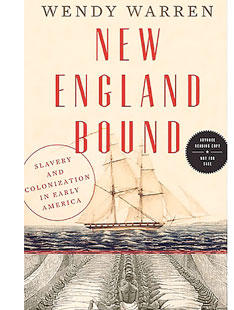Faculty Book: Wendy Warren: A New England History with Slavery Unbound Slavery

In 1638, 18 years after the Mayflower made shore, a Salem, Mass.-based ship named Desire returned from trading in the West Indies. Writing in his journal, John Winthrop, governor of the Massachusetts Bay Colony, recorded its cargo as cotton, tobacco, and “negroes, etc.”
American slavery usually is equated with the antebellum South’s plantation system, but Winthrop’s casual tone suggests this isn’t the whole story, as Wendy Warren, an assistant professor of history, recounts in her book New England Bound: Slavery and Colonization in Early America (Liveright). “There has remained something exceptional in both the popular and the scholarly understanding of early Colonial New England, an exceptional absence,” she writes.

The idea for the book came to Warren when, as a Yale graduate student, she happened upon a 17th-century travelogue containing a brief but agonizing account of the rape of a New England slave, ordered by an owner “desirous to have [more] Negroes.” The Northeastern location, the early date, and the woman’s utter isolation struck Warren. “It didn’t seem to fit what I already knew,” she says.
Researching New England Bound, which began as her doctoral dissertation, Warren visited more than 20 archives in New England, London, and Barbados. Because many slaves were disenfranchised and perhaps illiterate, their lives sometimes earned only a line or two in the historical record. To unearth their stories, it seemed simplest to Warren to read everything in a collection from before 1700; she reconstructed biographies from sources such as court records and wills in which slaves were bequeathed.
“It became apparent to me that a cradle-to-grave story was never going to be told — what I could tell was little snippets,” Warren says. “It’s like pointillist art. All the dots add up to a picture.”
Warren estimates that by the end of the 17th century there were about 1,500 African slaves in New England, living amid a population of 90,000 English settlers. “If you lived in a town, you probably could have seen an enslaved African every day,” she said. The colonists — who also exported hundreds of Native Americans as slaves, mostly after they were captured in wars — were motivated by profit as well as piety, since slavery was legal and seen as authorized by the Bible. Many of the settlers were merchants, “a term that can cover all manner of sins,” Warren says. “I think the stereotype is still very alive that they were somber people, dressed in black clothing, praying all the time.”
Unlike on the brutal Caribbean sugar plantations, New England slaves did the same work as settlers: They fetched water, fed cows, gardened, farmed, cut lumber, sapped trees. New England was known as “the Key of the Indies” for the role it played in keeping England’s lucrative sugar operations in Caribbean colonies flush with fish, beef, pork, peas, and other supplies. New England “had plantations,” Warren says. “They’re just offshore.”
In the late 18th century, slavery was declared unconstitutional in Massachusetts, and other New England states enacted emancipation laws. The history faded from popular memory or perhaps was superseded by the horrors in the South.











No responses yet